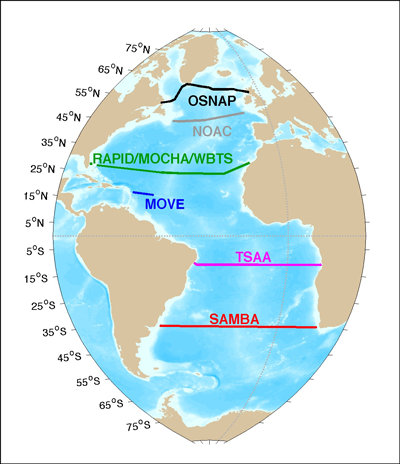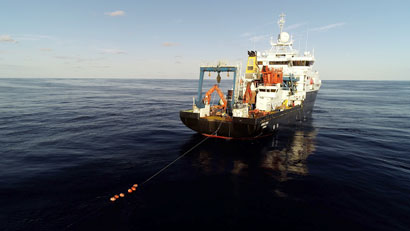The global overturning circulation system connects all of Earth’s oceans and redistributes mass, heat, salt, carbon, and nutrients. In the Atlantic Ocean, this overturning loop involves the formation of cold, deep waters in the high-latitude North Atlantic and warm, upper ocean waters entering the South Atlantic from other oceans. Over the past 2 decades, the ocean and climate science community has undertaken an international enterprise to observe and predict the Atlantic component of this phenomenon, known as the Atlantic Meridional Overturning Circulation (AMOC).
As part of this effort, the U.S. AMOC Science Team and the U.K. Rapid Climate Change Programme (RAPID) convened a meeting to discuss our present understanding of AMOC and its influence on weather, climate, and ecosystems. The meeting drew 103 scientists, and their presentations explored the oceanic regions (tropical, subtropical, and subpolar) over which common forcing mechanisms control AMOC variability. In addition, participants developed paleoproxies and fingerprints to help link present and past AMOC variations on timescales ranging from decades to millennia and examined feedbacks between AMOC and our changing environment.
The meeting’s many interactive discussions explored where we have consensus and where open questions remain. Tremendous progress has been made in building an international AMOC observing network, and concurrent observations are now available at multiple latitudes in the Atlantic, linking oceanic regions across both hemispheres. These observations include moored buoy networks (Figure 1), autonomous floats, ship surveys, satellite measurements, paleoproxies, and fingerprints. Collectively, these measurements are used to validate models, while the models in turn are used to elucidate AMOC mechanisms. Models can also ingest sparse observations to synthesize estimates of AMOC’s present state and forecast its future evolution.

As models improve and observational records grow from pilot studies to multidecadal records, new questions are emerging, challenging scientists to refine conceptual models of AMOC. Open questions include the following:
- Given low AMOC coherence across different regions on seasonal to interannual timescales, is AMOC spatially coherent on longer timescales?
- Can we integrate observations with models into a complete four-dimensional AMOC estimate?
- Should future efforts be focused on regions where high AMOC predictability is emerging in models?
- Can paleo and modern observational communities collaborate to develop better AMOC proxies, and how does the nonstationarity of AMOC affect their utility?
- Why are heat, salt, carbon, and nutrient transports so tightly coupled with AMOC?
- Does Labrador Sea deepwater formation affect AMOC decadal and multidecadal variability?
- Is the recent decline in AMOC strength part of a long-term trend?

The community remains energized to tackle these questions with an amazing suite of observations, improved models, and the new generation of AMOC researchers joining its ranks (as evidenced by about 30% of the attendees being early-career scientists).
Meeting presentations, the agenda, and AMOC research highlights are available on the AMOC website.
We acknowledge the U.S. Climate Variability and Predictability Program (CLIVAR; Mike Patterson, Kristan Uhlenbrock, and Jeff Becker) and the organizing committee (Renellys Perez, Martha Buckley, Gokhan Danabasoglu, Helen Johnson, Elaine McDonagh, Michael Spall, Meric Srokosz, and Richard Wood).
—Renellys Perez ([email protected]), Atlantic Oceanographic and Meteorological Laboratory, National Oceanic and Atmospheric Administration, Miami, Fla.; Meric Srokosz, National Oceanography Centre, Southampton, U.K.; and Gokhan Danabasoglu, National Center for Atmospheric Research, Boulder, Colo.


